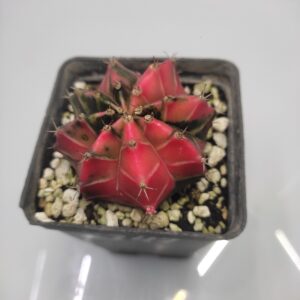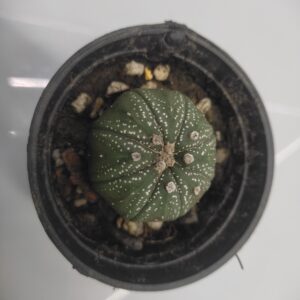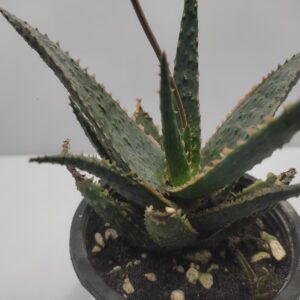Haworthiopsis limifolia, commonly known as the “Star Cactus,” is a charming succulent native to South Africa. This compact plant features striking, fleshy leaves that are thick and pointed, arranged in a rosette formation. The leaves are typically dark green with distinctive white, tubercle-like markings that give the plant its unique texture and appearance.
This species thrives in well-draining soil and prefers bright, indirect sunlight, making it an ideal choice for indoor environments. It’s drought-tolerant and requires minimal watering, only needing a drink when the soil has completely dried out. Haworthiopsis limifolia can reach a height of about 6 inches (15 cm) and can spread wider, making it a great addition to succulent collections, terrariums, or as a decorative tabletop plant.
In addition to its aesthetic appeal, this succulent is relatively low-maintenance and can adapt to various indoor conditions, making it perfect for both novice and experienced plant enthusiasts. With proper care, it can produce small, tubular flowers that bloom in summer, adding to its charm. Overall, Haworthiopsis limifolia is a delightful choice for anyone looking to add a touch of greenery to their space.
Light
Bright, Indirect Light: Place your Haworthiopsis limifolia in a spot where it receives bright, indirect sunlight. Direct sunlight can scorch the leaves, while too little light can cause the plant to become leggy12.
Watering
Moderate Watering: Water the plant when the soil is completely dry. Overwatering can lead to root rot. During the growing season (spring and summer), water more frequently, but reduce watering in the winter12.
Soil
Well-Draining Soil: Use a cactus or succulent potting mix that ensures good drainage. You can also add perlite or sand to improve drainage12.
Temperature and Humidity
Temperature: Haworthiopsis limifolia thrives in temperatures between 60-80°F (15-27°C). It can tolerate temperatures as low as 30°F (-1°C) for short periods but should be protected from frost12.
Humidity: This plant prefers low humidity and good ventilation3.
Fertilizing
Balanced Fertilizer: Feed with a balanced, low-nitrogen fertilizer diluted to half strength once or twice during the growing season3.
Pests and Diseases
Common Pests: Watch out for mealybugs and spider mites. Treat infestations with insecticidal soap or neem oil2.
Root Rot: Avoid overwatering to prevent root rot2.
Pruning
Minimal Pruning: Remove any dead or damaged leaves to maintain the plant’s appearance and health2.
Propagation of Haworthiopsis limifolia
Propagation by Offsets
Identify Offsets: Look for small offsets (pups) growing at the base of the mother plant.
Remove Offsets: Gently remove the offsets from the mother plant using a clean, sharp knife or by gently pulling them apart. Ensure each offset has some roots attached45.
Callus Formation: Allow the offsets to dry and form a callus over the cut areas for a few days to a week. This helps prevent rot when planted46.
Planting: Plant the offsets in a well-draining succulent mix. Place them in a small pot and water lightly46.
Care: Keep the newly potted offsets in a bright, indirect light location. Water sparingly until they establish roots46.
Propagation by Leaf Cuttings
Select Healthy Leaves: Choose healthy, mature leaves from the mother plant.
Cut and Callus: Use a clean, sharp knife to cut the leaves at the base. Allow the cut leaves to dry and form a callus for a few days47.
Planting: Place the callused leaves on top of a well-draining soil mix. Do not bury the leaves; just lay them on the surface47.
Watering: Mist the soil lightly to keep it slightly moist but not wet. Avoid direct watering until roots develop47.
Care: Place the cuttings in a bright, indirect light location. Roots and new growth should appear in a few weeks47.
By following these care and propagation tips, you can enjoy a healthy and thriving Haworthiopsis limifolia in your collection!







Reviews
There are no reviews yet.